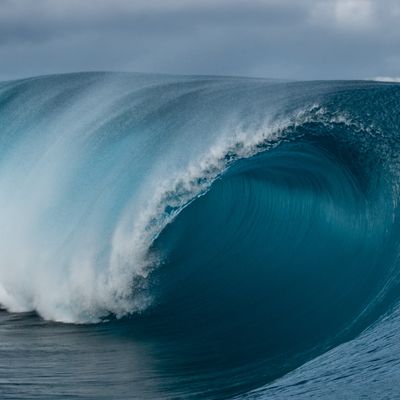

Teahupo‘o in all its glory.
Photo: Getty Images
NBC has an age-old formula for its Olympics broadcasts: Crank up the tension, hype the world’s best athletes until they either win or crumble under pressure, and, in between, run dozens of tear-jerky athlete backstory segments. Tie it all together with gleaming interstitial shots of the host city (as long as it’s not part of a despotic country). What corporate advertiser can resist forking over for all that?
NBC crews will have no trouble making Paris look stunning when the Games get underway on Friday. But the Eiffel Tower will have some serious competition from the backdrop for this year’s Olympic surf competition, 9,700 miles away in Tahiti. There, surfers will drop into a beautiful but terrifying wave called Teahupo‘o, which loosely translates to “place of skulls.”
If big waves arrive in the South Pacific from July 27 to August 5, expect to see a lot of this spot. It could be the backdrop to an action-packed drama set in paradise, or a horror show, or maybe even both. Either way, the competition there could be a breakthrough moment for surfing, if the waves don’t completely steal the spotlight from the people riding them.
“You kidding me? This is it,” said Griffin Colapinto, an Olympic surfer from California. “This is the chance to elevate the sport of surfing to another level. I know the athletes will be the ones to surf, but Teahupo‘o is the true star of the show.”
Teahupo‘o, which hosted the World Surf League’s most exciting contest this year, is so beautiful “it can take your breath away,” in the words of Hawaiian surfer John Florence, one of the favorites to win gold. But the wave also has the power to take lives away. People have died surfing here. Several weeks ago, an Australian surf photographer nearly drowned.
Surfing’s big moment will depend, as this sport so often does, on nature. Without much swell, Teahupo‘o is an accessible, turquoise wave that surfers can paddle into, stand up, turn left, and make three or so maneuvers. But on big days, Teahupo‘o mutates into an ultramarine-blue, ravenous tropical monster the size of a house. As the swell approaches its sudden shallow reef, water moves up the face of the wave so quickly that the bottom of it is actually below sea level — and unlike most waves, it is almost invisible from behind. At the back of the wave sits the entire Pacific Ocean.
Those who wipeout can get sucked up the face of the wave like an express elevator, then flipped and slammed onto the sharp, 5-foot-deep reef by the thick lip of the wave as it folds over. But for those who manage the steep drop and stay on their board long enough to be blown out of the collapsing barrel by an explosion of air and sea foam, it’s the ride of a lifetime. In a contest, the bigger the wave a surfer goes for, the farther inside they ride the tube, and the longer they stay inside before escaping what is essentially a collapsing building — which takes unbelievable nerve and a lot of experience — the higher the score they’ll earn.
“It’s really hard to explain how amazing it is once you’re in the barrel of the wave and you’re looking out at all the boats, and the mountains, and the feel of the pressure in the barrel,” said Florence, a two-time world champion and past winner of the prestigious Eddie Aikau big-wave contest.“It’s also one of the most terrifying waves in the world.”
The conditions at Teahupo‘o are challenging enough for seasoned veterans. But the field of competitors will look far different from an average pro-circuit contest in the World Surf League. They will include riders from unlikely surfing countries like Germany and Israel. Among the entrants is China’s 15-year-old Siqi Yang, who grew up on a farm hundreds of miles from the ocean, and has not been spotted by French Polynesian locals ever surfing at Teahupo‘o before. It’s easy to wonder how all this could go.
“It’s such a scary wave that if they don’t feel confident, they just won’t take off,” said Tim McKenna, a surf photographer who’s lived in Tahiti for 22 years and knows everyone who has (and hasn’t) visited Teahupo‘o in the past year to train. “I don’t see them charging just for the sake of charging, thinking they can make a name for themselves by doing crazy stuff.”
Teahupo‘o can rattle even the best. Two-time world champion Felipe Toledo of Brazil, who’s often unbeatable in smaller surf and will be competing in these Olympics, exited early in at least three past Teahupo‘o contests. He simply watched idly as big waves rolled past, and ended up earning low scores. (This is probably the main subplot that pro surfing fans are eager to see: If the waves are big, will Toledo paddle for one?)
Yet small waves here can also be dangerous. According to McKenna, these break over reef that’s only 1–2 feet deep. “I’ve got a friend who got paralyzed on a super small day,” he said. “But then I see guys wipe out on massive, 20-foot-plus days, in the worst possible spot, and they come up unscathed.”
Even if Teahupo‘o isn’t at its fiercest — the current wave forecast is all over the place — it will make for good television. But some in surfing could do without this kind of spotlight. Most everyday surfers generally resent seeing their sport become more popular, or be part of something so corporatized. Attention leads to bigger crowds, which is by far the most common gripe in surfing. The crowds lead to more competition for waves, more hostility in the water, more beginners (and their runaway surfboards) dangerously getting in the way, and more injuries. There is a robust corner of Instagram dedicated to these lurid collisions and confrontations.
“The Olympics are definitely not a good thing for people who surf,” said Chas Smith, author and co-founder of the arch surf website Beach Grit. “I think if the Olympics really pops, it could cause another surge in participation. It’s already a mess out there.”
Timing is everything, though. Nonconformism may be one of surfing’s selling points, but nowadays the industry is desperate. Built largely on swimwear and T-shirts, it was worth billions in the 2000s. But a feverish period of speculation, takeovers, and IPOs gave way to a spectacular crash in the 2010s. Most brands are now consolidated under a few private-equity groups that slap formerly valuable, youthful logos onto prescription eyeglasses, beard softeners and golf attire. Apart from Red Bull and other energy drinks, which offer lavish sponsorships, current pros earn a small fraction of what the previous generation did. The Olympics’ gaze promises a much wider audience, and the pros actually taking part are eager for it.
Carissa Moore, of Hawaii, dominated women’s surfing for years, winning five world titles, but she says more people know her for her gold medal at the 2020 Tokyo Olympics, which marked surfing’s debut at the Games. The 31-year-old is capping off her competitive career at this event.
“The last Olympics definitely exceeded my expectations about how much bigger it felt than a normal event,” she said. “There’s just a lot of people who don’t normally watch the WSL who watch the Olympics, and they understand what it means to win a gold medal.”
Florence sees larger benefits in welcoming others into surfing. “You grow a love and understanding for what we do, and being in the ocean, you’re like ‘OK, I get I get why they want to protect this,’ or how beautiful this thing is that we’re doing, and so in that sense I think the Olympics is an amazing thing for surfing.”
Even for people opposed to surfing in the Olympics, there is one doomsday scenario even worse. Some predict that if the contest at Teahupo‘o is a bust, the Olympics will turn to wave pools in the future. Never mind the fact that you can conjure waves “by putting down your credit card,” as Warshaw says — a giant machine that manufactures the perfect waves crushes the soul by destroying the complicated, give-and-take relationship with nature that is part of ocean surfing. It is the equivalent of a mechanical bull, a flight simulator, or a 100-meter final on a treadmill — devoid of romance or tension. The WSL’s wave-pool event was disliked and controversial, and it was taken off the tour this year. But wave pools offer convenience: no waiting for waves, no uncertainty: Just flip a switch. Which, in the TV world, with so much money on the line, is a much safer bet.
That would miss the whole point, though. Location matters in surfing more than perhaps any other sport, and whether surfing “belongs” in the Olympics or not, the sights, stakes and drama at Teahupo‘o have the potential to be better than any other event.
“Even surfers who don’t want surfing in the Olympics will tune in — but because it’s Teahupo‘o, not because it’s the Olympics,” Smith said. Getting together many of the world’s best surfers on a world-class wave with no one else out and a huge audience tuned in, and seeing who’s courageous enough to handle it all, is irresistible.
“Contests seem so divorced from what surfing means to me when I’m in the water,” said Matt Warshaw, curator of the immense Encyclopedia of Surfing . “But as a spectator, I really like when something’s taking place live and there’s something on the line. It’s fun to see who responds to that insane level of pressure, and Olympic pressure is just nuts.”
It’s up to Teahupo‘o, then — or more specifically, to any brewing storms in the Pacific or Southern Oceans — change the course of surfing, as the world tunes in.
Source link






